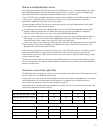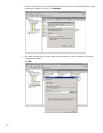
34
Backup job time, assuming no housekeeping or replication windows are set
Disk space pre-allocation
Some backup applications allow the user to choose whether to “pre-allocate” the disk space for each file at
creation time, i.e. as soon as a backup file is created an empty file is created of the maximum size that the
backup file can reach. This is done to ensure that there is enough disk space available to write the entire backup
file. This setting has no value for D2D devices because it will not result in any physical disk space actually being
allocated due to the deduplication system.
It is advised that this setting is NOT used because it can result in unrealistically high deduplication ratios being
presented when pre-allocated files are not completely filled with backup data or, in extreme cases, it will cause a
backup failure due to a timeout if the application tries to write a small amount of data at the end of a large empty
file. This results in the entire file having to be padded-out with zeros at creation time, which is a very time
consuming operation.
Block / transfer size
Some backup applications provide a setting for block or transfer size for backup data in the same way as for
tape type devices. Larger block sizes are beneficial in the same way for NAS devices as they are for virtual tape
devices because they allow for more efficient use of the network interface by reducing the amount of metadata
required for each data transfer. In general, set block or transfer size to the largest value allowed by the backup
application.
Concurrent operations
For best D2D performance it is important to either perform multiple concurrent backup jobs or use multiple
streams for each backup (whilst staying within the limit of concurrently open files per NAS share). Backup
applications provide an option to set the maximum number of concurrent backup streams per file device; this
parameter is generally referred to as the number of writers. Setting this to the maximum values shown in the table


















